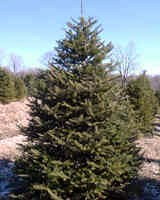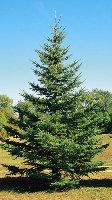Mon-Fri 9am - 5pm Mountain time
Canaan Fir vs Black Hills Spruce
Abies balsamea phanerolepis
Picea glauca var. densata
CUSTOM GROW
Canaan Fir, which is closely related to Balsam Fir, is known for its open-growing patterns and strong branches.
Canaan Fir is highly adaptable to many soil conditions and thrives in both shaded areas or direct sunlight. It is commonly used for Christmas tree farming or reforestation.
This rugged landscape tree remains green year-round.
Black Hills Spruce is a subspecies of White Spruce native to the Black Hills of South Dakota. It has a strongly conical form, slower growth rate and denser foliage than typical white spruce, making it preferable as a specimen tree for smaller suburban lawns. It also responds well to pruning, and can be used as a hedge or even bonsai.
Canaan Fir Quick Facts
Black Hills Spruce Quick Facts
In row spacing: 3 m (10 ft)
In row spacing: 3 - 4 m (10 - 12 ft)

